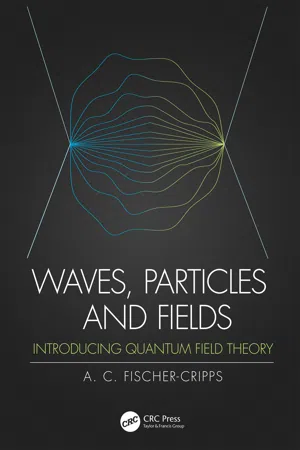
- 338 pages
- English
- ePUB (mobile friendly)
- Available on iOS & Android
About this book
Choice Outstanding Title, September 2020
This book fills a gap in the middle ground between quantum mechanics of a single electron to the concept of a quantum field. In doing so, the book is divided into two parts; the first provides the necessary background to quantum theory extending from Planck's formulation of black body radiation to Schrodinger's equation; and the second part explores Dirac's relativistic electron to quantum fields, finishing with an description of Feynman diagrams and their meaning.
Much more than a popular account, yet not too heavy so as to be inaccessible, this book assumes no prior knowledge of quantum physics or field theory and provides the necessary foundations for readers to then progress to more advanced texts on quantum field theory. It will be of interest to undergraduate students in physics and mathematics, in addition to an interested, general audience.
Features:
- Provides an extensive yet accessible background to the concepts
- Contains numerous, illustrative diagrams
- Presents in-depth explanations of difficult subjects
Frequently asked questions
- Essential is ideal for learners and professionals who enjoy exploring a wide range of subjects. Access the Essential Library with 800,000+ trusted titles and best-sellers across business, personal growth, and the humanities. Includes unlimited reading time and Standard Read Aloud voice.
- Complete: Perfect for advanced learners and researchers needing full, unrestricted access. Unlock 1.4M+ books across hundreds of subjects, including academic and specialized titles. The Complete Plan also includes advanced features like Premium Read Aloud and Research Assistant.
Please note we cannot support devices running on iOS 13 and Android 7 or earlier. Learn more about using the app.
Information
Mathematics 1
1.1 Introduction
1.2 Complex Numbers
1.2.1 Complex Numbers
Table of contents
- Cover
- Half-Title
- Title
- Copyright
- Contents
- Acknowledgements
- 1 Mathematics
- 2 Waves
- 3 Electromagnetic Waves
- 4 Kinetic Theory of Gases
- 5 Quantum Theory
- 6 The Bohr Atom
- 7 The New Quantum Theory
- 8 Relativity
- 9 Advanced Mathematics
- 10 Relativistic Quantum Mechanics
- 11 Probability Flow
- 12 Wave Functions and Spinors
- 13 Classical Field Theory
- 14 Lorentz Invariance
- 15 The Electromagnetic Field
- 16 The Quantum Field
- 17 Feynman Diagrams
- 18 Conclusion
- Appendix
- Index